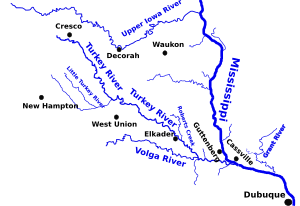Turkey River (Iowa) facts for kids
Quick facts for kids Turkey River |
|
|---|---|

Keystone Bridge in Elkader
|
|

Turkey River watershed
|
|
| Country | US |
| State | Iowa |
| District | Clayton County, Iowa, Fayette County, Iowa, Winneshiek County, Iowa, Howard County, Iowa |
| Physical characteristics | |
| Main source | 43°20′31″N 92°18′40″W / 43.342°N 92.311°W |
| River mouth | Mississippi River 607 ft (185 m) 42°43′03″N 91°00′43″W / 42.71750°N 91.01194°W |
| Basin features | |
| Tributaries |
|
The Turkey River is a river in Iowa, USA. It is about 153 miles (246 km) long. This river flows into the Mississippi River, which is one of the largest rivers in North America.
The Turkey River starts in Howard County, Iowa, near the town of Cresco. It then flows through several other counties, including Winneshiek and Clayton. Smaller streams, like the Little Turkey River, join it along the way.
The river flows generally from the northwest to the southeast. It passes by or through many towns. Some of these towns include Elkader and Elgin. Finally, it joins the Mississippi River south of Guttenberg. There is even a small community called Turkey River, Iowa named after the river, located right where it meets the Mississippi.
The area of land that drains into the Turkey River is called its watershed. This watershed is very large, covering about 1,083,200 acres (4,383 km²). This means all the rain and snow that falls in this huge area eventually flows into the Turkey River.
Exploring the Turkey River: Fun Facts and Nature
The Turkey River is not just a waterway; it's also home to many interesting places. These areas are great for enjoying nature and seeing wildlife.
Wildlife and Nature Spots Along the River
- Cardinal Marsh Wildlife Management Area: This special area is located a few miles southeast of Cresco. It's a protected place where animals and plants can thrive.
- Upper Mississippi River National Wildlife and Fish Refuge: The very end of the Turkey River, where it meets the Mississippi, is part of this large refuge. This refuge helps protect many different kinds of birds, fish, and other wildlife. It's an important place for nature conservation.

